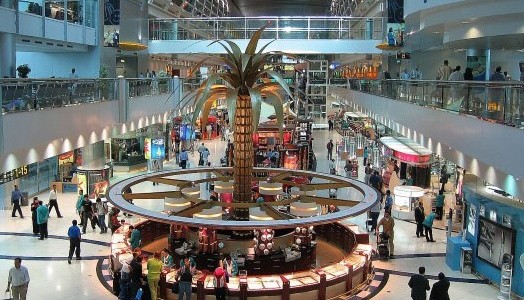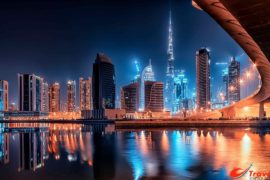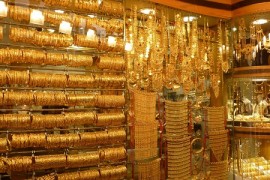Forget underwater hotels and buildings, the seven star hotel, the man-made islands, the world’s tallest tower, and spinning buildings, what the city of Dubai really knows how to create is chutzpan and headlines. This little fishing village of old has built an entire tourist industry out of piquing people’s curiosity. It’s finally tuned and unstoppable PR machine has managed to overcome every downside (who realises that Saudi Arabia, Iran and Iraq are right next door?) to make this city a must-see location. This is despite the fact that the region is abundant in sunny local areas which have much more to offer, including Jordan with its millennia-old civilisation, The Red & Dead Seas, the glories of Petra, and incredibly scenic desert landscapes – but generate far less interest than Dubai.
Dubai does, however have its virtues, and you will find no shortage of exciting things to see and do.
Cheap and Chic Eats – Eating Out
The city of Dubai is of the super-rich and the super-poor, the haves and the have-nots visibly apparent. The local-born Emiratis, about 12% of the population, are typically extremely wealthy. However, the town was built on the slog of a huge working-class population, predominantly arriving from the Indian subcontinent and less prosperous areas of the Gulf. In the midst of these groups, is an increasing number of expats, predominantly from the West, who are profiting to varying degrees from Dubai’s modern day ‘Gold Rush’. The best way to experience this class divide is through your stomach! At the top end is five-star cuisine at its very best, in fact Gordon Ramsay and Gary Rhodes have restaurants in the Hilton Dubai Creek and Grosvenor House Hotel respectively, both offer Michelin star cuisine. Nearly as good is the gastronomic feast available at the Chinese Noble House restaurant in the Raffles Hotel. At any one of these ‘top end’ places you will sample sensational fare in sumptuous surroundings amongst Emiratis and those who have profited from the city’s economic boom. Expect to pay about AED 500 (£80) per person for the privilege. At the other end of the social strata lies Al Dhiyafah Rd. Dubai’s ‘cheap-to-eat’ street. Here restaurants cater to the cities less affluent residents and visitors, and spill out onto the pavements so you can ‘people-watch’ as you feast on food from Lebanon, Iran and the Indian subcontinent. At the northern end of the street lies Sidra, offering zesty salads and huge mixed grills that give you a taste of the Levant. At the other end of Al Dhiyafah Rd., stands Pars Iranian Kitchen which serves fresh seafood and succulent lamb straight from its outdoor grill. Opposite Pars (although to get there you will have to navigate six lanes of traffic!) Is Pakistani Ravi Restaurant, one of the city’s best regarded, though down-to-earth in presentation, curry houses.
As you probably know, due to licensing laws, restaurants outside hotels cannot serve alcohol, but as you’re probably paying less than £15 for a meal for two, who is to argue?
Shopping
The point of note about shopping in Dubai is that the actual shopping is average, but the experience is intriguing. If you shopped in Paris or New York, Dubai’s malls will be a disappointment. Most of the shops are familiar and no cheaper than in other places in the world. You may, however, find the odd electronics bargain. But such are the malls in this city of unrestrained fantasy, they cannot fail to lure you and your credit card inside.
The Souk Madinat located inside the Madinat Jumeirah Hotel, has, for example, its own water way to transfer people from its shops, restaurants and bars to their neighbouring hotels. The huge Mall of the Emirates has an indoor ski slope with real snow, if you should fancy a quick slalom midst shopping and visiting the beach. The Khan Murjan Souk advertises itself as an example of Islamic authenticity, unparalleled in the region; it connects the Wafi Mall, home to Chanel, Montblanc and Marks & Spencer’s, with the Raffles Hotel. The Mall of Arabia opened in 2008, at the time, the largest mall in the world, at 10,000,000 ft.², with a real-life “Jurassic Park” type ‘dinopark’, called Restless Planet, the beasts being authentic-looking mechanical animals.
The Gold Souk
Dubai is renowned for very cheap gold, but you will have to haggle for it, and a stroll of the Gold Souk is a must. Also on offer are platinum, diamonds and occasionally silver. The government keeps tight control over the quality of the merchandise, so you may rest assured your purchases will be genuine and authentic. If something in the window takes your fancy, do not forget to barter, bartering can lead to the merchants dropping their asking price considerably, by as much as half.
Less atmospheric, but even cheaper, is the Gold and Diamond Park, where unique designs can be found or jewellers are able to recreate pieces for you at fraction of the cost of the original piece.
Champagne Brunch
This is a Muslim state, but perversely, alcohol flows liberally. By law, it may only be served within the confines of a hotel, but with approximately 500 hotels in the emirate, some with as many as 28 bars, clubs and restaurants you will not be left thirsty.
If your stay in Dubai takes in a Friday (the first day of the Arabic weekend) then you can experience at first-hand the city’s strained relationship with the bottle. While leaving the holiest day of the week for Muslims, many of the city’s restaurants open their doors for ‘Champagne brunch’. This brunch is not the sedate culinary experience it is elsewhere. In Dubai it is an experience of excess, with an abundance of alcohol and gargantuan buffets, with the gourmet and glutton begging for mercy.
Spectrum on One in the Fairmont Hotel and Le Meridien’s Yalumba each offers unlimited champagne (Moet & Laurent Perrier, respectively) and tables heaving under the strain of prime steak, oysters and gigantic prawns. Spectrum is the most civilised of the two, whilst Yalumba often degenerates into a ‘dancing-on-the-tables’ affair, with occasional trouble ensuing. For those who fancy indulging alfresco, the superb Mina A’Salam offers outdoor seating, life cooking stations and even a kids club.
If you are in the mood for an evening tipple only, the places to head for are, the open-air 360 Degrees, an out-at-sea rooftop bar yards from the famed Burj Al Arab, Bar 44 in the Grosvenor House, with its panoramic views of newly built Dubai or Le Meridien Mina Seyahi’s Barasati, a real beach bar on the shoreline.
Burj Al Arab
The Burj Al Arab hotel’s seven star rating is an urban myth got out of hand, all the same, apt, because nothing dominates the Dubai skyline and tourist’s imagination quite like it. Probably the world’s least subtle hotel, gold leaf being applied as liberally as undercoat, a fleet of white Rolls-Royces on the forecourt and mesmeric dancing fountains in the foyer, nobody ever came to Dubai for understatement! The only means to gain entry to the hotel without having to pay for a room, could be to book in at one of the many hotel’s expensive restaurants. On the top floor is Al Muntaha, although it’s bafflingly bright interior prevents one from seeing the awesome views below, this is an expensive fish restaurant, containing a vastly huge aquarium. Sahn Eddar serves wonderful afternoon tea. Probably the best is the beach-based Majlis Al Bahar, where, from here, you can admire the Burj’s impressive exterior, (the hotel’s beauty being on the outside), before instructing the maitre d’ that you will be taking your nightcap in the top-floor’s cocktail bar, where you can gaze at the city’s ‘over-the-top’ garishness.
The Traditional Dubai
Whilst vast swathes of the city have been demolished in the relentless drive towards modernisation, one neighbourhood remains the quiet fishing village it once was. The Bastakia Quarter, which squeezes itself between the Dubai Creek and the bustling Bur Dubai district, is a mini maze of wind-towered buildings, many of which have been transformed into cafes and art galleries. Commence your tour at XVA Gallery, which specialises in contemporary modern art from across the Gulf region. Continue on to the Majlis Gallery, before lunching on refreshing mint and lime juice and hearty salads in the neighbouring, Basta Art Café’s Courtyard.
As soon as you have rejuvenated, weave your way through the textile souk, in which you can buy magnificent bolts of fabrics, along with the less inspiring tat, and onto the Creek where you can either join the commuters for an abra (water taxi) ride across the water for a AED 1 (15p) cost, or hire your own boat for a scenic waterway tour. Back in port, head to the interesting but small Dubai Museum to discover how oil and ambition combined to make this modern oasis. If you get hungry again, try Bastakiah Nights, a Lebanese atmospheric restaurant, with a lovely rooftop area.
Man-Made Islands
The most audacious of all of Dubai’s projects is the collection of reclaimed islands, closely offshore. The first of these was the palm-tree-shaped Palm Jumeirah, which the city boasts as the eighth wonder of the world. There are two other islands, Jebel Ali and Deira. Jebel Ali features a breakwater which spills out a selection of poems by Dubai’s ruler Sheikh Mohammed bin Rashid Al Maktoum. Lastly, admire The World, an archipelago of islands which forms a map of the world in miniature. Boat trips are the best way to view these islands, and a number of companies offer trips to get you out into the Gulf. Try Dusail, Art Marine or Bristol Marine who offer stately yachts, motorboats and also speedboats.
The Beach
You’ll definitely want to see the shore whilst in Dubai. The top-end beach hotels have partitioned off most of the sand, so if you are not staying on the Jumeirah beach strip, the alternative is Al Mamzar, a public beach near the neighbouring emirate of Sharjah, although the road that connects the city’s, is frustratingly inaccessible during the working week. Other good alternatives are Jumeirah Beach Park AED 5 (80p) entrance fee or the free stretch of sand running the length of Umm Suqeim, also known as Kite Beach, for obvious reasons. If you desire a more extravagant beach sensation, a handful of hotels enable you to wallow in their white sands for a small charge. Try Le Meridien Mina Seyahi AED 250 (£40) for the experience.
The Desert
A visit to the desert isn’t as peaceful as you might expect. The desolate Sahara is worlds away. The easiest way to visit the dunes outside the city, is on a four-wheel-drive safari. These tours are incredibly popular, but your pleasure will depend on your tolerance of being thrown around the sand in a jeep, naff touristy barbecues in the desert with a belly dancer, henna painting opportunities, and numerous other tourists. If you can handle all of this then Blue Banana has several expeditions on offer. They also provide hot air balloon flights over the sand at sunrise, a far nicer and statelier experience. If you wish only to see some sand without the nausea or vertigo, and then visit the plush desert escape of Bab Al Shams, where you can sit on the rooftop and enjoy a cocktail in the sunset.
Golf
Golf is an obsession in the city of Dubai, so if you wish to mingle with celebrities on the green, visit the courses designed by Ernie Els & Colin Montgomerie. Even better, head to the city’s most famous course, The Emirates Golf Club, which hosts the annual Dubai Desert Classic; this is a stunning course, whose 18th hole has one of the finest approaches in the world. Almost as impressive is the Dubai Creek Golf and Yacht Club, which boasts a challenging par 72 course together with a fun pitch ‘n’ putt course, and also an impressive clubhouse, whose architecture resembles that of the Sydney Opera House. Tee times go quickly, so be sure to book in advance, this especially being so if you wish to take a swing at Tiger’s Tee, the first holes designed by Tiger Woods – the Tiger Woods Dubai, is a private golf community and resort, which opened in September 2009.



